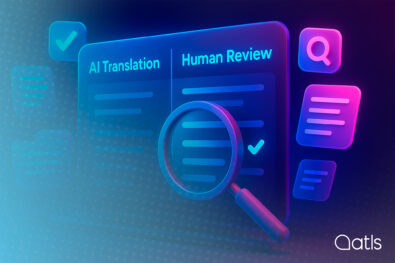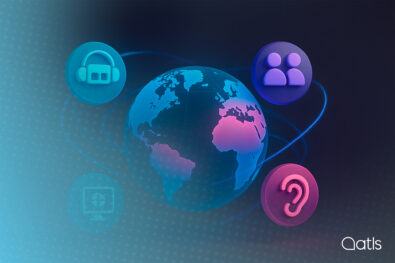Maybe it's because of the hype, information overload or simply because things have not been explained well or understood properly. Whatever the reason, confusion surrounding assisted translation and machine translation is rife. ATLS uses the FLOW translation program, which features translation AI, to prevent such things from happening again in the future.
With quantum computing around the corner (so to speak) and the idea that 'progress moves at an astonishing speed' more applicable than ever, it is important to have a very clear understanding of how to deal with your company's translation needs (for example, a classic: translate your website into English) to make it effective and competitive.
What is assisted translation?
The complete term is “computer-assisted translation” or "CAT". No matter how much the term is debated, the definition is clear: translation process where the translator is assisted by computer software that has been specifically designed for this purpose.
Broadly speaking, CAT tools usually include a set of functions and work as follows:
- Pre-translation: neural translation is here to stay. FLOW fully leverages this technology and delivers a high-quality pre-translation to ensure the translator never has to start from scratch and can work faster.
- Translation memories: they are directories of previous translations in the same context. They use them to find the results of previous translations, which they can reuse without having to translate them again. This produces consistent and uniform translations.
- Terminology databases: it is important to have a glossary of frequently used terms that indicates the customer's preferences to serve as a translation guide.
- Language quality assurance: the program can easily find terms that might not be consistent with memories and databases, and can also highlight spelling mistakes, formatting problems, etc. and submit them to the reviewer.
Differences between assisted translation and machine translation
The first problem here is the terminology, which is extremely confusing (largely because the language industry has failed to explain it properly). For the purposes of clarification: machine translation does not involve humans.
The other big difference is the timeline. Almost all translators who currently work in the sector have used CAT tools since they began translating. The concept of translation AI itself has recently emerged due to the development of artificial neural networks and neurolinguistic programming.
How does the FLOW assisted translation program work?
So, we currently have two very different translation models: machine translation and assisted translation, which is used by translators to obtain professional results. Machine translation has the following features:
- The machine does the high volume work, while the translator oversees the process using their expertise.
- Translation AI is gradually being integrated into CAT tools.
- The tool is both a translation and workflow management program.
- There are more and more “agency translation programs,” i.e. proprietary software.
At ATLS, our range of translation technology solutions includes our own assisted translation program that involves translation AI. It is called FLOW, and it gives the customer more control over an increasingly agile and reliable translation process. Let's look at it step by step, from the perspective of a customer who requires a large volume translation.
The content to be translated is important
Firstly, the material has to be imported, i.e. “put into” the translation program. Up until recently, this was a real pain in the neck for any project manager; FLOW accepts virtually any format (txt, docx, xlsx, xml, json, xliff, csv, yaml, idml, html, etc.).
We can also do manual imports, in one go or in batches); or, with our plugins and API, you can import content automatically from your website or CMS.
Assign it to a trusted translator or let ATLS handle it for you
The customer's first important decision: do you want to do your translations in FLOW, or would you rather use ATLS' translation services?
You can get ATLS to manage your workflow, or automate it completely in FLOW. This will save you a lot of time without sacrificing quality.
Translate the content or stick with the AI translation
It is also possible to just use machine translation, or get assistance from professional translators. As we said above, assisted translation software includes neural translation AI that provides good results (which are also faster and more cost-effective).
Export the final result
With just one click, you can export your translation (which may have been done by a human or a machine) and add it to your CMS again, publish it on your website (if you have one of our plugins and proxies) or download it in the same format as the original document.
Benefits of using FLOW for assisted translation
Whether you are going to use it in an e-commerce context, or if you need it to translate internal corporate material (annual accounts, marketing campaigns, technical procedural manuals, etc.), using FLOW has several clear benefits.
Make the translation process faster
The first benefit is clear. Cutting all repetitive tasks from a manual job saves time, right? CAT tools are to the translator what the electric screwdriver is to the mechanic.
In fact, it is not only faster, but also more coherent. Imagine this scenario: translate two million words from Swedish automotive manuals into Turkish. Dozens of translators will work on it. Does everyone translate the same? With a CAT tool, yes.
Highly accurate multi-language coverage
In many cases, coherence goes hand in hand with accuracy. Terms that are specific to a particular industry or work environment must be used correctly, particularly in complex contexts where there is no margin for error.
Let's continue with the same example: Turkish employees in the automotive industry must have the precise term, with no ambiguities or errors; if you also need to translate content into Czech, Russian and Polish, FLOW makes this easier.
Efficiency in multilingual settings
Non-experts might not notice, but the loaning of terms and "mutation" of languages often occurs in multilingual groups, companies or regions, and this leads to the creation of specific formats.
This is problematic when we leave this environment. Let's say that some Turkish employees trained in Sweden use a German term for a particular part or product (which is commonplace there). The quality assurance aspect of the translation program helps prevent these issues.
In-house or ATLS translation options
In our experience, the customer's main consideration is (as always) how to find the right balance between cost (time and money) and quality. Is it worth doing a translation in-house? This is something to be considered in each case.
Professional translation agencies have access to different types of software that have been specifically developed for assisted translation (in our case, we use FLOW, which was developed exclusively for us). It's the winning combination, because:
- A human translator with no access to specific technology will produce an excellent translation, but they will be slow (and expensive).
- Machine translation software will be very quick and cheap, but will it be reliable?
- And a human translator using free machine translation software... Will ultimately do what they can...
Flexible translation management with FLOW
Would you prefer your own translators or ATLS to do it? Maybe you're not sure, or perhaps it depends on the situation. Both options are equally valid, and FLOW allows any combination of both. Functionality is added to this flexibility: you can assign tasks internally or designate them to ATLS with a couple of clicks, without having to leave the platform or wait for emails.
You can therefore take control of the keywords for your next international SEO campaign or the adaptation of your catalogue of services for new foreign markets. Or delegate the translation of your internal training materials and the subtitling of your promotional videos... But only if you want to! Maybe that's the best thing about FLOW: the flexibility that gives you, whilst maintaining quality and competitive prices.






